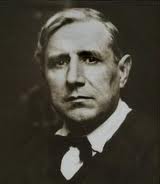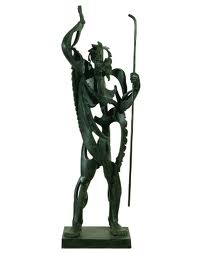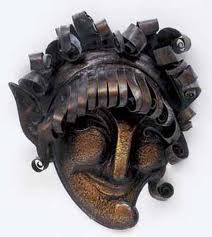Avant-garde: Pablo Gargallo
Pablo Gargallo was a Spanish sculptor and painter. He is considered by critics to be one of the most important and innovative sculptors of the 20th Century, especially in the area of Spanish avant-garde.
Pablo Gargallo (1881-1934)

Gargallo was born in Maella in Zaragoza which is in the Spanish region of Aragon, but he moved with his family to Barcelona in 1888. His father owned an ironworks in which Gargallo learned how to forge the metal. Pablo Gargallo began to study in Barcelona, training in the arts and working for Eusebi Arnau in his workshop. He also studied at the Escuela de Bellas Artes de La Lonja (School of Fine Arts of La Lonja).
After this, Pablo Gargallo spent a lot of time in Paris, France. In 1903, Gargallo decided to live in an artist's commune in Le Bateau-Lavoir. Here he met many famous artists such as Pablo Picasso and Juan Gris, both of which had a different influence on Pablo Gargallo's life. Juan Gris actually introduced Pablo Gargallo to Magali Tartanson, the woman that would become his wife in 1915. Pablo Picasso was a big influence on Gargallo's work. Pablo Gargallo even used Picasso's head as a model for one of his sculptures.
Pablo Gargallo's style consisted in two parts. The first was a classical style, mostly related to Modernism and Noucentisme. Meanwhile, his other style was much more experimental and vanguard: Gargallo enjoyed experimenting with space, different shapes and varied materials. Gargallo began experimenting with sheet metals such as copper and iron. From 1911 to 1912, Pablo Gargallo produced his first set of mask like works which had a strong cubist feel to them.

Pablo Gargallo flourished in producing three-dimensional objects from one-dimensional sections of different types of materials, such as metal, paper and cardboard. This was due to the influence of his friend Julio González, another Spanish sculptor. These sculptures were often completed in a Cubist or Minimalist style. They would sometime be lacking things such as his sculpture 'Kiki de Montaparnasse' which only has one eye, half a nose and half a mouth. His more traditional style sculptures were made from bronze, marble and other materials.
Gargallo's works varied considerably. At one stage of his life, Pablo Gargallo produced three works about the Swedish actress, Greta Garbo: 'Masque de Greta Garbo à la mèche' (Mask of Greta Garbo in wax), 'Tête de Greta y los Garbo avec chapeau' (Head of Greta and the Garbo with a hat) and 'Masque de Greta Garbo aux cils' (Mask of Greta Garbo's eyelashes).
He also collaborated with another artist called Dídac Masana, in order to construct the archway over the stage at the Palau de la Música Catalana in Barcelona. This decorative piece depicts the Ride of the Valkeries from Wagner's opera 'Die Walkure' (The Valkyries).

Some of his best know works were a culmination of his Cubist concept of sculpture. These include 'El profeta' (The Prophet) (1933) and 'Kiki De Montparnasse' (1928). 'El profeta' (The Prophet) combines an artistic energy with biblical tradition. For all of his works, Pablo Gargallo is considered to be one of the most famous vanguard artists of Spain and the world.
In 1920, Gargallo was named a teacher of sculpture at 'Escuela Técnica de Oficios Artísticos de la Mancomunidad de Cataluña' (The Technical School of Artistic Crafts of the Community of Catalonia). However, three years later, Gargallo left for Paris permanently after the installation of Primo de Rivera, the Spanish dictator who ruled from 1923 until 1930.
In 1934, Gargallo suffered pneumonia and died in Reus, Tarragona. He had only just travelled to the town in order to put on an exhibition of his work. The Pablo Gargallo museum opened in the Spanish town of Zaragoza in 1985, and this is where you can study the sculptor's works and life. It contains a lot of documentation detailing Gargallo and other famous Spanish sculptures of the time.
